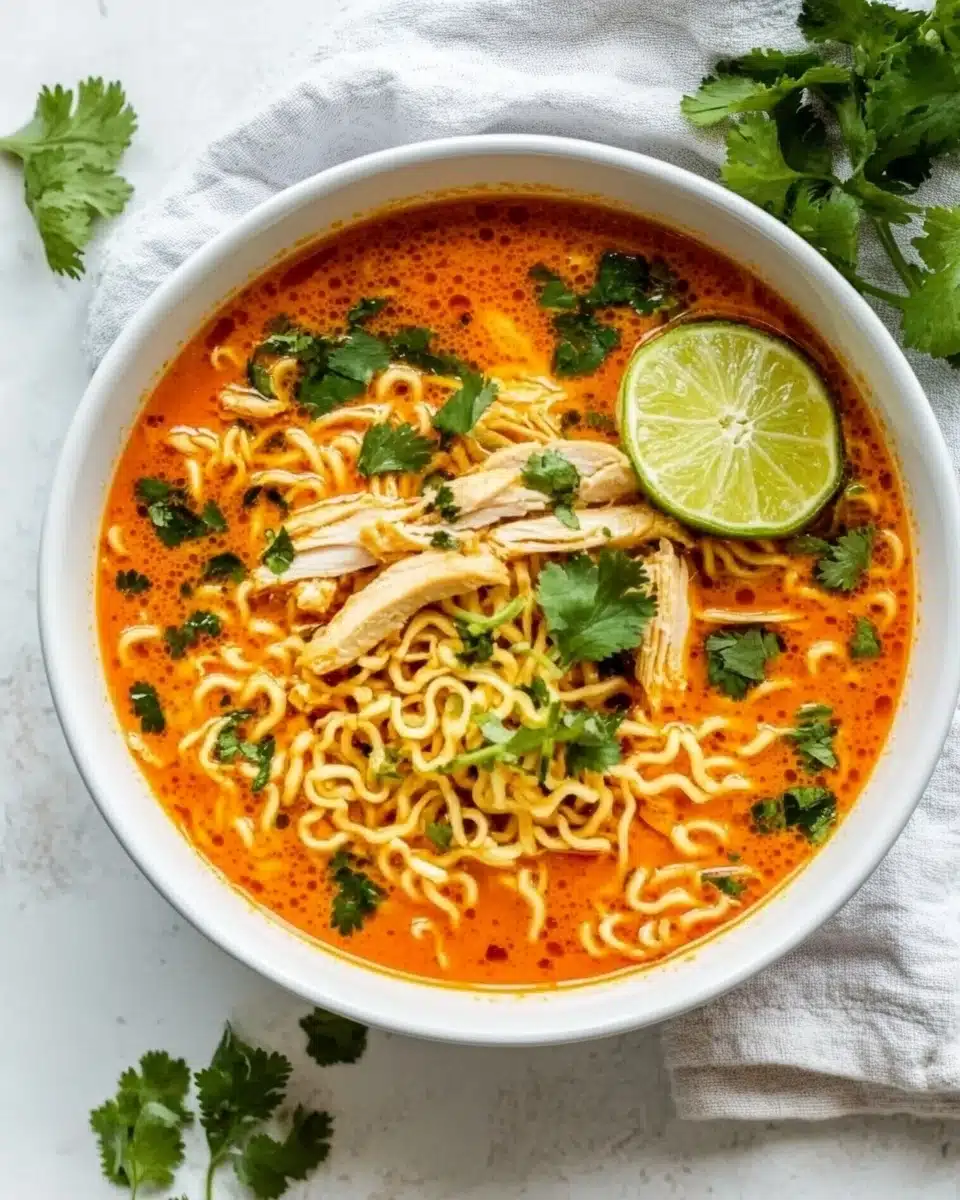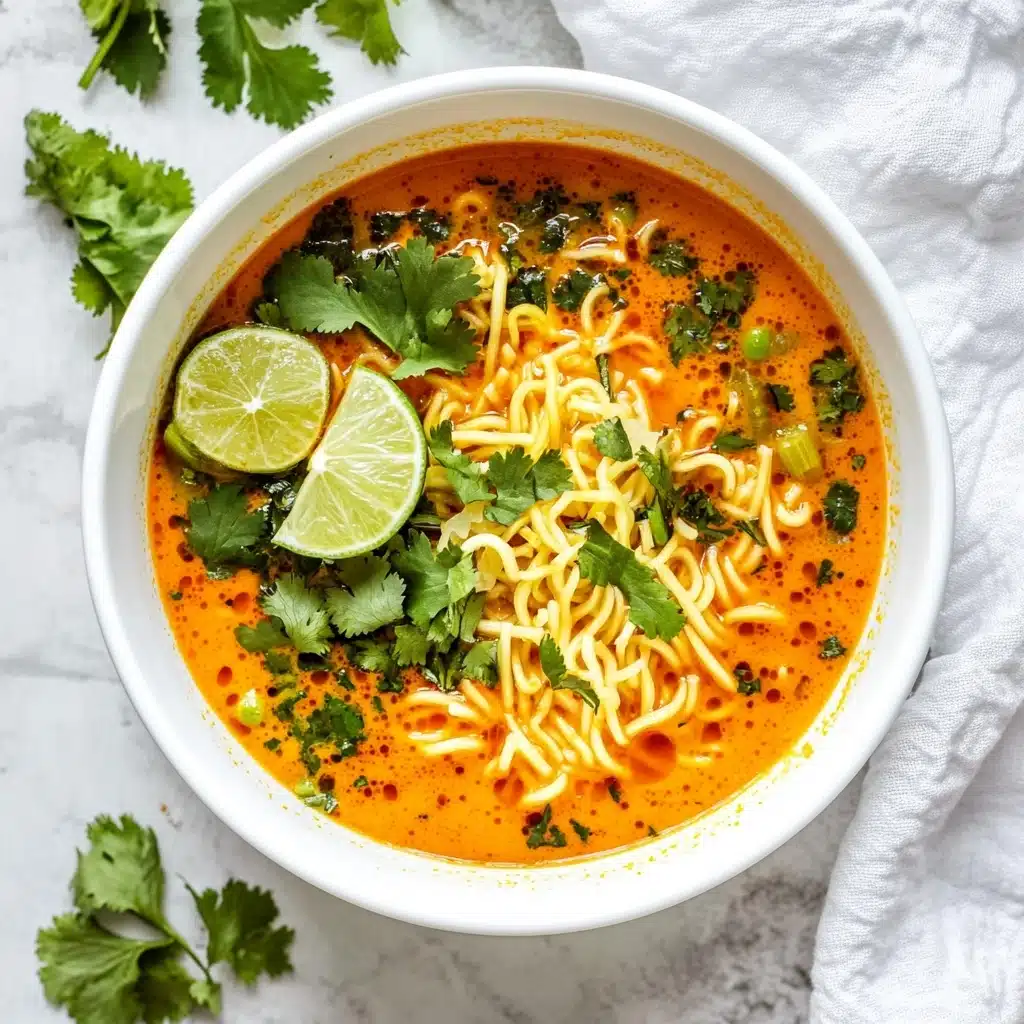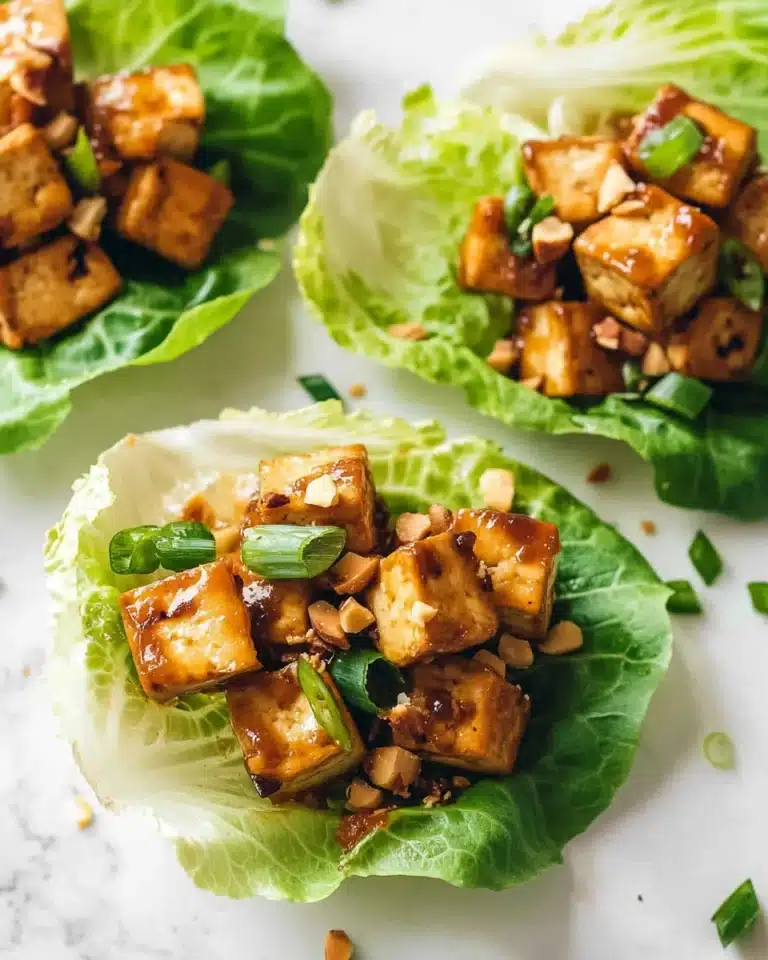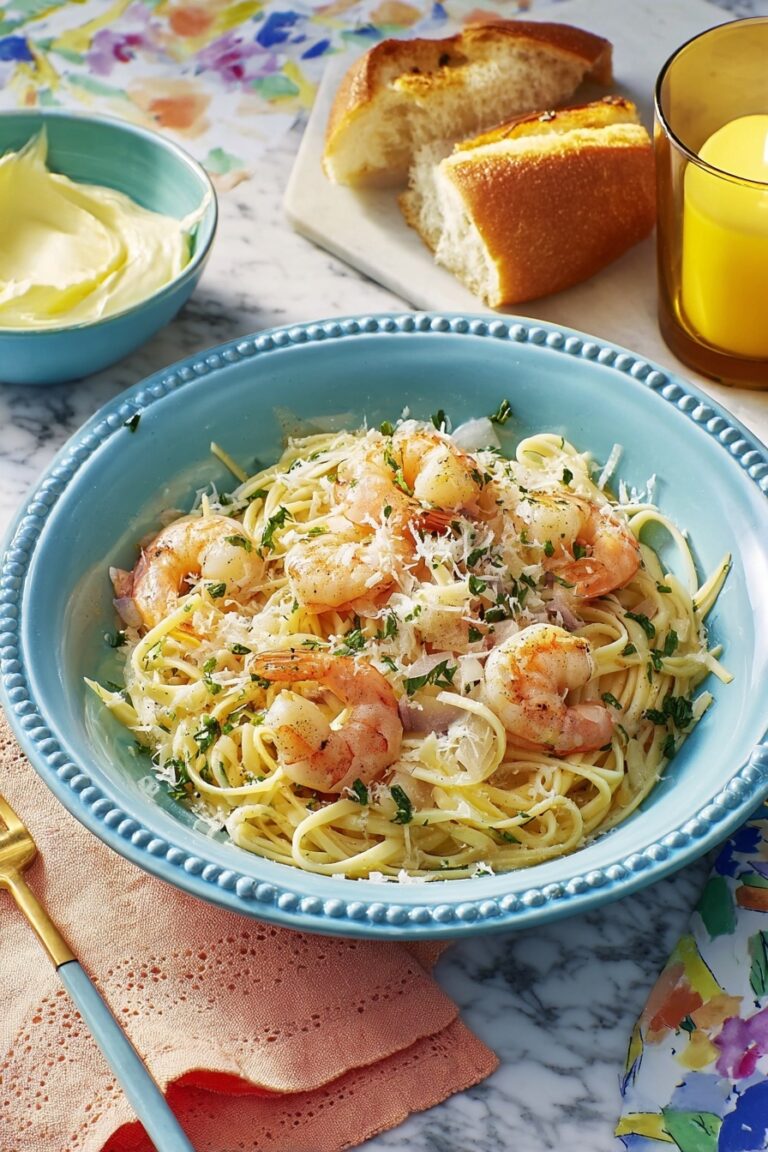This Thai Red Curry Soup is a hug in a bowl—bold, aromatic, and utterly comforting! It’s brimming with silky coconut milk, tender noodles, and vibrant veggies, all swirled together in a fragrant, just-spicy-enough red curry broth that will transport your senses straight to Thailand.
Why You’ll Love This Recipe
- Big Thai flavors, simple steps: This soup bursts with all the cozy, aromatic depth of your favorite Thai restaurant—right from your own kitchen, no intimidating ingredients list required.
- Totally customizable: You can make it veggie, vegan, or bump up the protein with a quick toss-in of shredded chicken, shrimp, or tofu.
- Ready in under 40 minutes: It’s weeknight-friendly and perfect for those “I want something amazing, but I’m hungry now!” moments.
- Creamy, slurpable, and soul-warming: There’s something irresistible about the way silky coconut broth and soft noodles tangle together—so comforting, you’ll crave it on repeat!
Ingredients You’ll Need
One of the best things about Thai Red Curry Soup is that the ingredient list is refreshingly straightforward, but each element plays an important role in achieving that crave-worthy balance of creamy, spicy, tangy, and savory flavors.
- Avocado oil or olive oil: Either oil works beautifully for sautéing and provides a neutral base that lets the curry flavors shine.
- Yellow onion: Brings natural sweetness and savory depth to your broth.
- Red bell pepper: Adds brightness, crunch, and a gorgeous pop of color.
- Carrots: For earthy sweetness and beautiful texture.
- Garlic: There’s just no skipping the aromatic magic of fresh garlic.
- Freshly grated ginger: Wakes up the soup with its zingy, warming notes—don’t be shy here!
- Red curry paste: The star of the show, infusing every spoonful with savory heat and classic Thai flavor (see the note below on brand and spice level).
- Chicken broth or vegetable stock: Use your favorite—either keeps the soup rich and satisfying. Veggie stock makes this soup vegan-friendly!
- Full-fat coconut milk: For an utterly creamy and luscious base that’s essential to Thai Red Curry Soup.
- Fish sauce: Adds that classic umami punch and depth. If you’re vegetarian, substitute with soy sauce or vegan fish sauce for similar savory notes.
- Ramen or rice noodles: These provide body and slurp-factor to the soup. (Check the noodle note below!)
- Fresh lime juice: Adds brightness at the finish and balances out the richness perfectly.
- Fresh chopped cilantro: Brings herby, citrusy freshness right at the end and as a garnish.
- Lime wedges: A must for serving—let everyone add their own zing!
Variations
This Thai Red Curry Soup is wonderfully flexible, so you can make it truly your own, no matter what’s calling to your taste buds—or what’s in your fridge. Feel free to get creative and swap in your favorites!
- Make it vegan or vegetarian: Simply use vegetable stock and swap the fish sauce for soy sauce or a vegan alternative. The result is just as vibrant!
- Add protein: Try shredded rotisserie chicken, sauteed shrimp, baked tofu, or even leftover roast veggies for some extra heartiness.
- Change up the noodles: Rice stick (Pad Thai) noodles give a more traditional texture, while curly ramen noodles make it extra fun and kid-friendly.
- Boost the veggies: Toss in baby spinach, snap peas, mushrooms, or zucchini in the last few minutes of simmering for even more color and nutrition.
How to Make Thai Red Curry Soup
Step 1: Sauté the Veggies
Start by heating avocado or olive oil in a Dutch oven or large soup pot over medium heat. Add your diced onion, bell pepper, and carrot. Cook, stirring occasionally, until everything is softened and fragrant—about 5 to 7 minutes. This gives your soup a sweet, flavor-packed foundation.
Step 2: Bloom the Aromatics & Curry Paste
Add in the minced garlic, freshly grated ginger, and Thai red curry paste. Stir constantly as everything sizzles for about a minute. This blooming step is where the magic happens—the paste and aromatics open up, releasing deep, complex flavors into the oil.
Step 3: Build the Broth
Next, pour in your chicken broth (or veggie stock), coconut milk, and fish sauce. Season with a touch of salt and black pepper. Give everything a good stir, then bring the soup up to a gentle simmer. Let it cook, uncovered, for about 5 minutes to allow the flavors to meld and deepen.
Step 4: Add Noodles
Stir the noodles directly into the simmering broth. Let them cook until they’re just tender. The exact cooking time will depend on your noodles—ramen usually takes just a few minutes, while rice noodles might need a bit longer. Check the package for the perfect timing!
Step 5: Finish with Lime & Herbs
Turn off the heat and stir in the fresh lime juice and chopped cilantro. Give it one last taste—add another squeeze of lime or a dash more fish sauce if you want more brightness or savoriness. Serve hot, with extra cilantro and lime at the table.
Pro Tips for Making Thai Red Curry Soup
- Choose Your Curry Paste Wisely: Brands of Thai red curry paste vary widely in spice and salt, so start with less and add to taste—you can always bump up the heat, but you can’t take it away!
- Coconut Milk Matters: Use full-fat coconut milk for a creamy, lush soup. Light coconut milk can be used in a pinch, but won’t give the same richness or depth.
- Noodle Timing: If you plan to save leftovers, cook noodles separately and add them just before serving; this prevents them from turning mushy in the soup.
- Layer Your Lime: Add the juice at the end for a fresh pop, but serve with extra lime wedges—different palates love different levels of zesty brightness.
How to Serve Thai Red Curry Soup
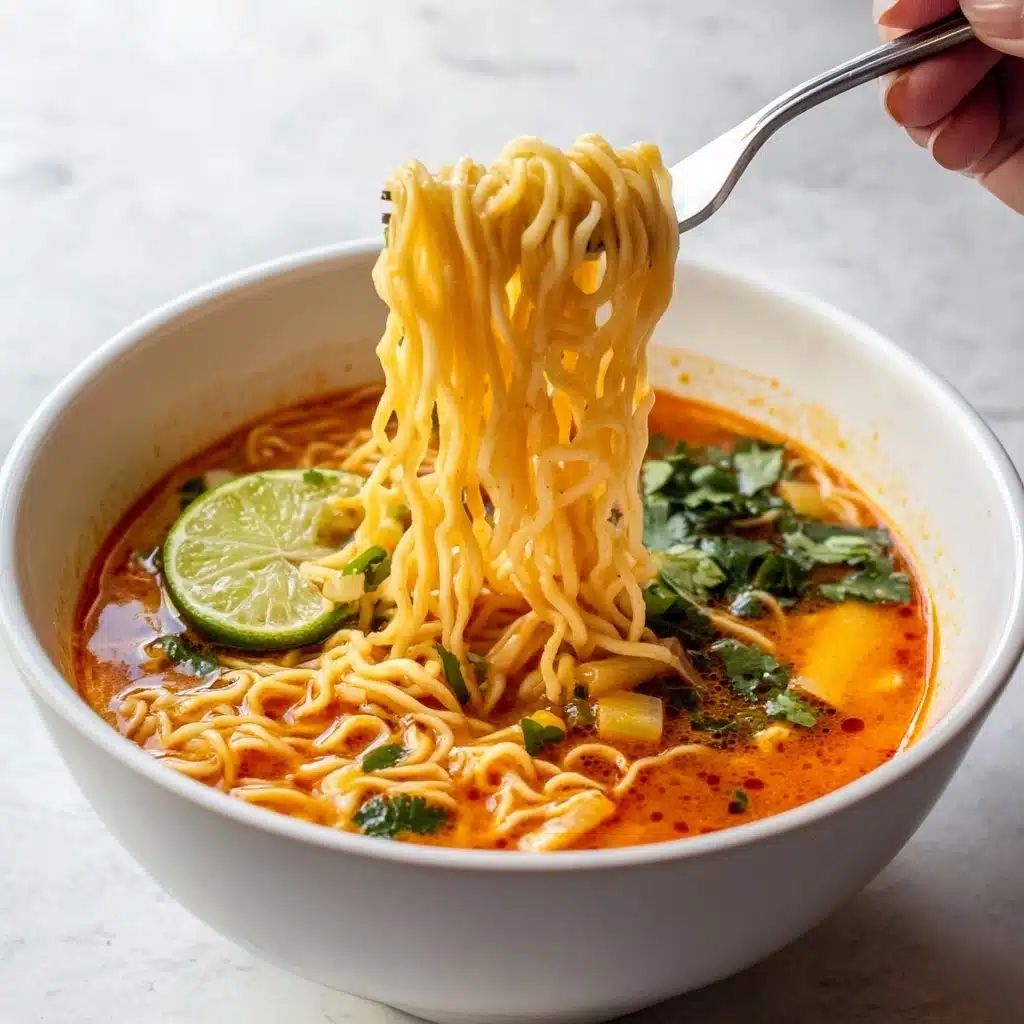
Garnishes
The best part about Thai Red Curry Soup is piling on those colorful garnishes! A sprinkle of extra cilantro, thinly sliced red chili, scallions, or a swirl of coconut milk not only makes it look gorgeous but adds layers of flavor and texture. Fresh basil and a handful of bean sprouts bring another hit of freshness if you have them handy.
Side Dishes
While this soup can absolutely stand alone as a main meal, it’s lovely with a side of jasmine or coconut rice to soak up every last drop. For a light starter, try some crispy spring rolls or a tangy Thai cucumber salad—you’ll have one phenomenal feast!
Creative Ways to Present
If you want to impress, ladle the soup into big bowls and add a dramatic drizzle of chili oil or a spoonful of roasted peanuts for crunch. Or try serving the noodles and broth separately at the table for a fun, interactive dinner—everyone can build their perfect bowl!
Make Ahead and Storage
Storing Leftovers
Thai Red Curry Soup keeps beautifully for 3-4 days in the fridge. For best results, store the noodles and broth separately if possible to prevent the noodles from soaking up all the liquid and going soft. Simply reheat and combine when you’re ready to eat!
Freezing
The base of this soup (without noodles or fresh herbs) freezes well for up to 2 months. Portion into airtight containers and let it thaw overnight in the fridge before reheating. Add fresh noodles and herbs after thawing for the best flavor and texture.
Reheating
Gently warm the soup in a saucepan over medium heat, stirring occasionally. If the soup thickens in the fridge, just add an extra splash of broth or coconut milk to loosen it up. Add cooked noodles at the end and heat through for the perfect bowl every time.
FAQs
-
Can I make Thai Red Curry Soup gluten-free?
Absolutely! Just use rice noodles instead of ramen noodles, and double-check that your curry paste and fish sauce are labeled gluten-free. Most Asian markets carry gluten-free versions of both if needed.
-
What can I use instead of fish sauce?
You can swap in soy sauce, tamari, or a vegan fish sauce for a similar salty, savory depth. You’ll still get plenty of umami along with a plant-based spin!
-
How spicy is this soup, and how do I adjust the heat?
The heat level depends mostly on your brand of curry paste. Start with a tablespoon or two and taste as you go. Add more if you like extra spice, or balance it out with additional coconut milk and lime if it gets too fiery.
-
Can I add protein directly to this soup?
Yes! Shredded rotisserie chicken, cubes of pan-fried tofu, or peeled shrimp can all be added after the noodles—just make sure any raw proteins are fully cooked through before serving.
Final Thoughts
If you’re looking for a bowl of pure comfort with a little kick, there’s truly nothing like homemade Thai Red Curry Soup. It’s vibrant, customizable, and guaranteed to warm both your belly and your spirits. I hope you give it a try—make it your own, and let it become a new favorite at your table!
Print
Thai Red Curry Soup Recipe
- Prep Time: 15 min
- Cook Time: 20 min
- Total Time: 35 min
- Yield: 6 servings
- Category: Soup
- Method: Stovetop
- Cuisine: Thai
- Diet: Vegetarian
Description
This Thai Red Curry Soup is a comforting and flavorful dish that combines the richness of coconut milk with the bold flavors of red curry paste. Loaded with vegetables and noodles, this soup is a complete meal in a bowl.
Ingredients
Vegetables:
- 2 Tbsp. avocado oil or olive oil
- 1/2 cup diced yellow onion
- 1/2 cup diced red bell pepper
- 1/2 cup diced carrots
Seasonings:
- 3 garlic cloves, minced
- 1 Tbsp. freshly grated ginger
- 1/4 cup red curry paste
Liquid and Noodles:
- 6 cups chicken broth or vegetable stock
- 1 (14 oz.) can full-fat coconut milk
- 3 Tbsp. fish sauce
- 4–5 oz. ramen or rice noodles
- 1 Tbsp. fresh lime juice
- 1/2 cup fresh chopped cilantro
Instructions
- Saute Vegetables: In a dutch oven, heat oil over medium heat. Add onions, red bell pepper, and carrots. Cook until tender, about 5-7 minutes.
- Add Seasonings: Stir in garlic, ginger, and red curry paste. Cook until fragrant for about 1 minute, stirring frequently.
- Cook Soup: Add chicken broth, coconut milk, and fish sauce. Season with salt and pepper. Let it simmer for 5 minutes. Add noodles and simmer until tender.
- Finish: Stir in lime juice and cilantro.
Notes
- Curry Paste: The strength of curry paste varies. Thai Kitchen brand is recommended.
- Noodles: Ramen or rice noodles are best. Avoid ultra-thin noodles like vermicelli.
Nutrition
- Serving Size: 1 serving
- Calories: 320
- Sugar: 5g
- Sodium: 1100mg
- Fat: 20g
- Saturated Fat: 14g
- Unsaturated Fat: 4g
- Trans Fat: 0g
- Carbohydrates: 30g
- Fiber: 3g
- Protein: 6g
- Cholesterol: 0mg

